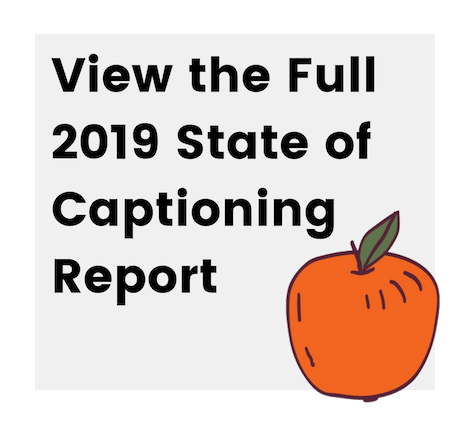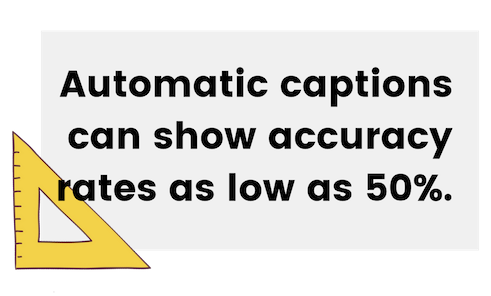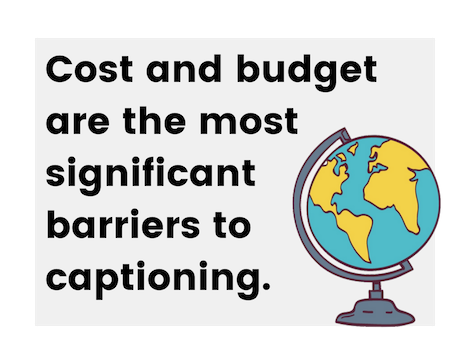Automatic Captions: Are They Helping or Hindering Students?
Updated: June 11, 2019
In the 2019 State of Captioning report, 37% of respondents indicated that they use automatic captions for educational videos. At the same time, 50% said that they’re aware automatic captions don’t fulfill the legal requirements. These findings seem to conflict, so I had to ask, what’s going on here? Are certain barriers preventing organizations from seeking captioning solutions beyond automatic captioning?
In this post, you’ll read about the top barriers to captioning and discover how those barriers may be affecting the ability of organizations to provide accurate captions. You’ll also learn why organizations continue to use automatic captions for educational content even though it may not fulfill their legal requirements. Don’t worry, I won’t let you go without a game plan. I’ll also show you how to overcome common captioning barriers and provide tips on how to gain buy-in for accessibility at your organization.
But first, let’s discuss why automatic captions alone don’t cut it for video content, especially educational content, and why they may be hindering rather than helping learners.
What’s the Deal With Automatic Captions?
Automatic captions use automatic speech recognition (ASR) technology to transcribe audio and synchronize text with videos to create closed captions. That might sound fancy or complicated, but in reality, using ASR alone to create captions is detrimental to the quality of the captions.
For ASR to turn out more accurate captions, many conditions must be true, such as little or no background noise, minimal grammatical errors or mispronunciations, among other conditions. If any of these conditions don’t exist, caption accuracy can drop as low as 50%, meaning that half of the video will be transcribed incorrectly, thus spitting out highly inaccurate captions. To this, I say, “No thank you!”
If audio conditions are pristine, even the most state-of-the-art ASR technology will only deliver accuracy rates around 80%. The key to 99% or higher caption accuracy is human interaction. Don’t get us wrong, ASR is an excellent tool because it does much of the transcribing work and makes it easier for a human to swoop in afterward and clean things up. As long as automatic captions are used in conjunction with human editing, there’s really no issue.
The problem arises when we leave the captioning process up to ASR technology on its own. With this practice, viewers who can’t hear will be relying on incorrect info, and viewers who can hear are left to keep up with choppy captions that make no sense. This leaves everyone feeling utterly confused. *Crying emoji*
Caption Quality and Accuracy – Why It Matters
Now, you may be asking yourself why caption accuracy is so important.
Inaccurate captions negatively affect the perceived quality of video content, but more importantly, they don’t adequately communicate the message of the video to those who rely on captions to engage with video content. People who are deaf or hard of hearing often need captions to watch videos at all, but error-riddled captions force them to sort through a jumbled mess or exclude them from the content entirely.
Talk about frustrating.
Caption accuracy is crucial for all content but is especially vital for educational content. Findings from an Oregon State University study found that students use captions as a learning aid to help them focus, to retain information, and to aid with comprehension. Furthermore, not all learners who use captions are deaf or hard of hearing, rather 80% of caption-users do not have hearing loss at all. The importance of digital media in education is increasing as more and more educators use videos as a teaching medium. Educational video may come in the form of recorded lectures, study materials, and presentation videos. All of that content must be accessible, and yes, that means it should be accurately captioned.
Take this case for example: In 2015, the National Association of the Deaf sued Harvard University for allegedly failing to caption public online video content and for providing inaccurate closed captions where they did exist. This suit has yet to be settled after years of motions and hearings, and in March 2019, it was announced that the case would move forward in federal court. Though it’s unclear what the outcome will be, it is clear that courts are considering whether or not inaccurate captions for public video content are compliant with the Rehabilitation Act and the Americans with Disabilities Act.
I’m not saying that all organizations using automatic captions for educational content will be sued, but providing inaccurate captions may increase that risk. If you have access to legal counsel, consider consulting them to determine which accessibility laws apply to your organization.
Top Barriers to Captioning
Now it’s time to talk about those pesky captioning barriers and why they may be affecting organizations’ ability to provide accurate captions.
Across the board, 36% of State of Captioning 2019 respondents said that cost and budget were the most significant barriers to captioning video content. For the education industry and educational content creators, cost and budget were the top captioning barriers, as opposed to other barriers like resource time or technical challenges.
Automatic captioning is usually free to do. For example, YouTube, the second-largest search engine in the world, offers a free automatic captioning tool for users that upload videos to the platform. Is this the reason why organizations that share educational content resort to automatic captions? Could it be that they don’t have the buy-in to hire individuals to clean-up automatic captions or to outsource captioning to a third-party vendor?
Though 50% of survey respondents said that they know inaccurate captions may not fulfill accessibility requirements, it’s possible that they often resort to using automatic captions due to lack of funds. While some may argue that using automatic captions is better than not captioning at all, inaccurate captions are not truly accessible and could hinder the purpose of educational content especially for those relying on captions as an accommodation.
One question remains, though: What can be done to combat cost barriers and to move towards accurately captioning educational content?
How to Get Captioning Buy-In at Your Organization
Organizations may need to establish a captioning budget to move away from strictly relying on automatic captions. With that budget, they can either implement an in-house captioning process or utilize a third-party vendor. Now that we’ve determined how automatic captions can compromise the integrity of captions let’s talk about ways to get captioning buy-in at your organization.
First and foremost, be an accessibility advocate. Don’t make the mistake of assuming that every member and employee at your organization knows what accessibility is or why it’s valuable. Your goal is to spread awareness and to help your co-workers understand the importance of accessibility. You can do this by hosting a workshop where you can distribute information and resources. Keep it simple, and make it clear that accessible content benefits everyone.
The next step is to reiterate the ROI of captioning. High-quality captions provide added value for your audience, keeps viewers coming back for more, and ensure people take your organization seriously. It’s all about user experience when it comes to video, and inaccurate captions don’t provide a positive experience. For example, NASA recently shared a launch video on social media. The video, which used Facebook’s automatic captioning, received negative attention due to the abundance of captioning errors. This is all to say that inaccurate captions make videos memorable, but not in a good way. By allocating a captioning budget and moving away from automatic captions, it will improve the viewing experience for everyone and benefit your organization in the long run.
The last step is to propose a pilot captioning program. A pilot program allows you to test the ROI of captioning, and it reveals what accessibility can do for your organization. Begin by setting a small budget to caption a handful of videos either with a third-party vendor or in-house. Be sure to set a beginning and end date for the program and determine which metrics you’ll track, such as video views and website visits. Take time to analyze and compare accurately-captioned video metrics to automatically-captioned video metrics. Remember, the purpose of a pilot program is to tangibly demonstrate the value of setting a captioning budget, which will help your organization move away from using automatic captions.
In Conclusion…
Videos are being used more and more to educate and inform people. Accurate captions have the power to make educational videos accessible and to enhance the learning experience, but for now, automatic captions do not provide the level of quality that is considered accessible nor acceptable.
Though barriers to captioning hinder organizations from seeking higher-quality captioning solutions, there are things we can do to advocate for accessibility within our organizations. Only when we begin educating our peers and voicing the value of accurate captions can we begin to make all educational video content truly accessible.











